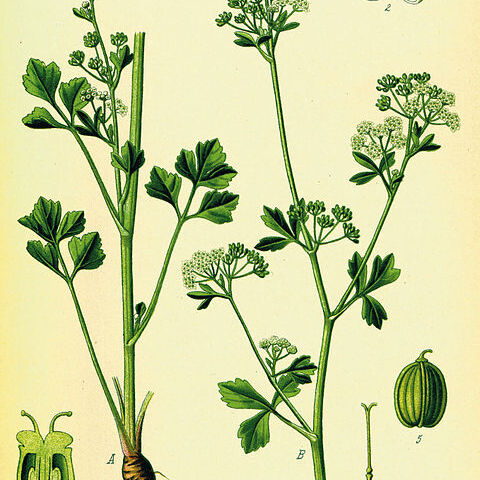Robust to slender, erect to creeping, annual, biennial or perennial herbs. Leaves variously pinnate or ternate. Umbels compound, sessile or pedunculate, usually leaf-opposed; bracts 0–few; bracteoles few–numerous. Flowers hermaphrodite. Calyx-teeth obsolete or very small. Petals small, white or greenish, sometimes with a short incurved lobule but rarely emarginate above. Fruit glabrous, almost round to elliptic-oblong, laterally compressed; primary ribs conspicuous, slender to very thick; valleculae 1-vittate, the narrow commissure 2-vittate; stylopodia low, very shortly conical or flat, styles slender to obsolete; carpophore entire to shortly bifid at the apex. Endosperm roundish to quite sharply pentagonal in section.
Annual, biennial, or perennial glabrous herbs from taproots or creeping root-stocks; stems erect to prostrate, usually branched, the leaves petiolate, pinnate to ternate-pinnately decompound, the petiole sheathing; inflorescence of compound (or frequently some simple) umbels with or without an involucre and involucel; flowers white or greenish, the petals with an inflexed apex, the calyx minute or obsolete; stylopodium short-conical to depressed, the styles short, the carpophore entire, bifid, or 2-cleft; fruit compressed laterally and constricted at the com-missure, the ribs filiform, prominent, obtuse, the vittae solitary in the intervals, 2 on the commissure; seed subterete, its face flat.
Glabrous annual, biennial or perennial herbs, usually with taproots, sometimes rooting at nodes. Lvs 1-3-pinnate; segments broad or narrow. Umbels usually compound, often ± sessile and lf-opposed, sometimes shortly pedunculate; bracts few and simple or 0; bracteoles several or 0. Petals white or greenish, regular, with entire, obtuse to acute, usually inflexed apex; calyx teeth minute or 0. Fr. ovoid-oblong to subglobose, slightly flattened laterally, not beaked, spinless; commissure narrow; ribs 5 per mericarp, equal, stout or slender; vittae solitary in furrows.
Annual, biennial or perennial herbs, erect or creeping, usually taprooted, glabrous. Leaves alternate, pinnate or stem leaves sometimes ternate; leaf segments broad to linear. Inflorescence terminal or leaf-opposed, pedunculate to ± sessile, usually compound; bracts and bracteoles small or usually absent. Sepals minute or absent. Petals ovate to suborbicular, inflexed at apex, white or greenish white. Fruit ellipsoidal, ovoid or subglobose, slightly flattened laterally; mericarps 5-ribbed; oil canals sometimes present.
Fr oval to rotund, flattened laterally, somewhat constricted along the commissure; ribs 5 per mericarp, elevated; oil-tubes solitary in the intervals, 2 on the commissure; carpophore entire or not cleft beyond the middle; umbels terminal and lateral, compound, the lateral sometimes sessile; umbellets small; sep minute or none; pet white or greenish-white; stylopodium short-conic to depressed; lvs once pinnate to decompound. 10, widespread.
Umbels compound, us. lf-opposed, often subterminal; involucral bracts and bracteoles few to 0; calyx-teeth 0 or minute; petals white, ovate, acute, ± inflexed. Fr. subovoid, laterally compressed; commissure narrow; mericarps distinctly, obtusely 5-ribbed; vittae large, in furrows. Annual to perennial glab. herbs with compound lvs. Widely distributed genus of some 50 spp.
Fruit ovoid to globose, somewhat laterally compressed, glabrous to slightly setulose, slightly constricted at the commissure. Ribs thick and rounded, vittae solitary in the intervals, with 2 on the commissural face.
Robust or slender annual, biennial or perennial herbs; stems erect, decumbent or creeping.
Seed round to subpentagonal in section, with the commissural face plane.
Flowers white to greenish in compound umbels; bracts and bracteoles 0.
Petals ovate to suborbicular, with an inflexed apex.
Stylopodium shortly conical or depressed.
Carpophore entire or slightly 2-fid.
Calyx teeth minute or absent.

